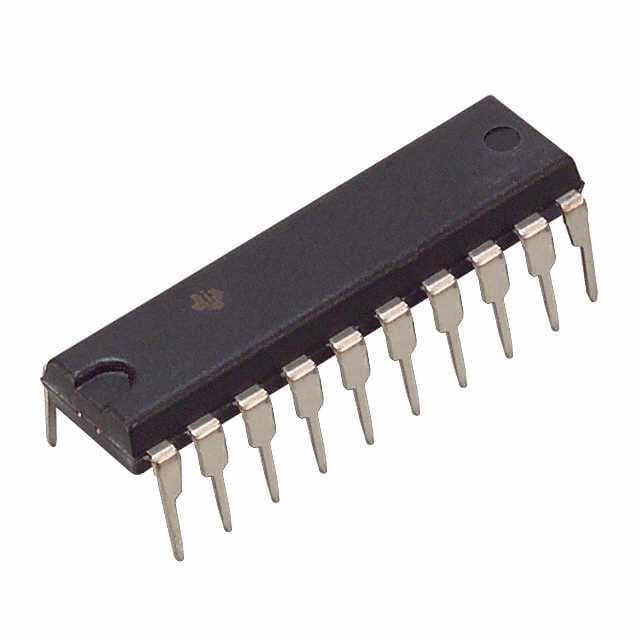SN74ALS245A-1NG4
Product Overview
Category
The SN74ALS245A-1NG4 belongs to the category of integrated circuits (ICs).
Use
This IC is commonly used for signal level shifting and bus interface applications.
Characteristics
- High-speed, low-power device
- Compatible with TTL (Transistor-Transistor Logic) and CMOS (Complementary Metal-Oxide-Semiconductor) logic families
- Bidirectional data transfer capability
- Eight-bit wide, non-inverting transceiver
- 3-state outputs for bus-oriented applications
Package
The SN74ALS245A-1NG4 is available in a standard 20-pin DIP (Dual In-line Package) format.
Essence
The essence of this product lies in its ability to facilitate efficient and reliable data transfer between different logic families.
Packaging/Quantity
The SN74ALS245A-1NG4 is typically packaged in reels or tubes, with each reel containing 2,000 units.
Specifications
- Supply voltage: 4.5V to 5.5V
- Input voltage range: 0V to VCC
- Output voltage range: 0V to VCC
- Operating temperature range: -40°C to +85°C
- Propagation delay time: 10ns (max)
- Output current: ±24mA
Detailed Pin Configuration
The SN74ALS245A-1NG4 has a total of 20 pins, which are assigned specific functions as follows:
- DIR (Direction Control)
- GND (Ground)
- B0 (Data Bus Bit 0)
- B1 (Data Bus Bit 1)
- B2 (Data Bus Bit 2)
- B3 (Data Bus Bit 3)
- B4 (Data Bus Bit 4)
- B5 (Data Bus Bit 5)
- B6 (Data Bus Bit 6)
- B7 (Data Bus Bit 7)
- VCC (Supply Voltage)
- OE (Output Enable)
- A0 (Address Bus Bit 0)
- A1 (Address Bus Bit 1)
- A2 (Address Bus Bit 2)
- A3 (Address Bus Bit 3)
- A4 (Address Bus Bit 4)
- A5 (Address Bus Bit 5)
- A6 (Address Bus Bit 6)
- A7 (Address Bus Bit 7)
Functional Features
The SN74ALS245A-1NG4 offers the following functional features:
- Bidirectional data transfer: Allows data to be transmitted in both directions, making it suitable for bus interface applications.
- Non-inverting transceiver: Ensures that the output signal is an exact replica of the input signal.
- 3-state outputs: Enables multiple devices to share a common bus without interfering with each other.
Advantages and Disadvantages
Advantages
- High-speed operation: The SN74ALS245A-1NG4 can handle data transfers at a fast rate, making it ideal for time-critical applications.
- Compatibility: It is compatible with both TTL and CMOS logic families, providing flexibility in system design.
- Low power consumption: This IC consumes minimal power, contributing to energy-efficient designs.
Disadvantages
- Limited voltage range: The operating voltage range is restricted to 4.5V to 5.5V, which may not be suitable for all applications.
- Propagation delay: The propagation delay time of 10ns (max) may introduce slight delays in data transmission.
Working Principles
The SN74ALS245A-1NG4 operates based on the principles of digital logic. It uses a combination of transistors and other electronic components to facilitate the bidirectional transfer of data between different logic families. The direction control pin (DIR) determines the flow of data, while the output enable pin (OE) enables or disables the outputs.
Detailed Application Field Plans
The SN74ALS245A-1NG4 finds applications in various fields, including:
- Microcontroller interfacing: It is commonly used to interface microcontrollers with external devices, such as sensors, displays, and memory modules.
- Industrial automation: This IC plays a crucial role in connecting different components within industrial automation systems, allowing for efficient communication and control.
- Communication systems: It is utilized in communication systems to interface between different logic levels, ensuring seamless data transmission.
- Automotive electronics: The SN74ALS245A-1NG4 is employed in automotive electronics for signal level shifting and bus interface applications.
Detailed and Complete Alternative Models
Some alternative models that offer similar functionality to the SN74ALS245A-1NG4 include:
- SN74LVC245A: Low-voltage
Lista 10 Vanliga frågor och svar relaterade till tillämpningen av SN74ALS245A-1NG4 i tekniska lösningar
Sure! Here are 10 common questions and answers related to the application of SN74ALS245A-1NG4 in technical solutions:
1. What is the SN74ALS245A-1NG4? - The SN74ALS245A-1NG4 is a bidirectional octal bus transceiver with 3-state outputs. It can be used to enable bidirectional transfer of data between two buses.
2. What is the voltage range supported by SN74ALS245A-1NG4? - The SN74ALS245A-1NG4 supports a voltage range of 4.5V to 5.5V.
3. How many channels does the SN74ALS245A-1NG4 have? - The SN74ALS245A-1NG4 has 8 channels, allowing for bidirectional data transfer on each channel.
4. What is the maximum data transfer rate supported by SN74ALS245A-1NG4? - The SN74ALS245A-1NG4 can support data transfer rates up to 24 MHz.
5. Can the SN74ALS245A-1NG4 be used as a level shifter? - Yes, the SN74ALS245A-1NG4 can be used as a level shifter to convert signals between different voltage levels.
6. Is the SN74ALS245A-1NG4 compatible with TTL logic? - Yes, the SN74ALS245A-1NG4 is compatible with TTL logic levels.
7. Does the SN74ALS245A-1NG4 have built-in ESD protection? - Yes, the SN74ALS245A-1NG4 has built-in ESD protection, making it more robust against electrostatic discharge.
8. Can the SN74ALS245A-1NG4 be used in both parallel and serial communication systems? - Yes, the SN74ALS245A-1NG4 can be used in both parallel and serial communication systems, depending on the application requirements.
9. What is the power supply voltage required for SN74ALS245A-1NG4? - The SN74ALS245A-1NG4 requires a power supply voltage of 5V.
10. Can the SN74ALS245A-1NG4 be used in automotive applications? - Yes, the SN74ALS245A-1NG4 is suitable for automotive applications as it meets the necessary standards and specifications.
Please note that these answers are general and may vary based on specific application requirements. It's always recommended to refer to the datasheet and consult with technical experts for accurate information.


